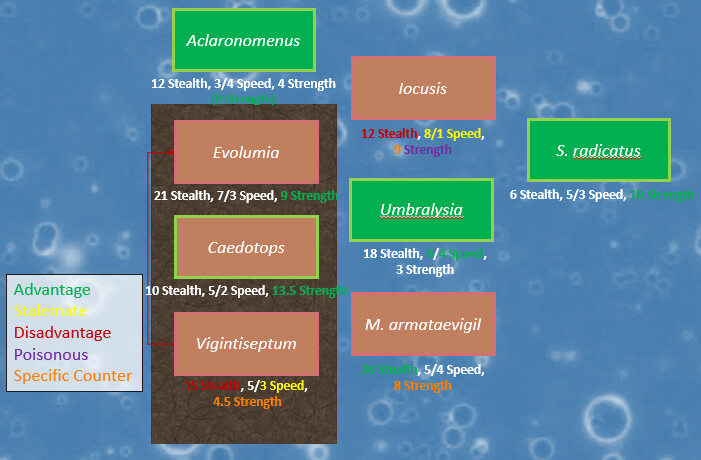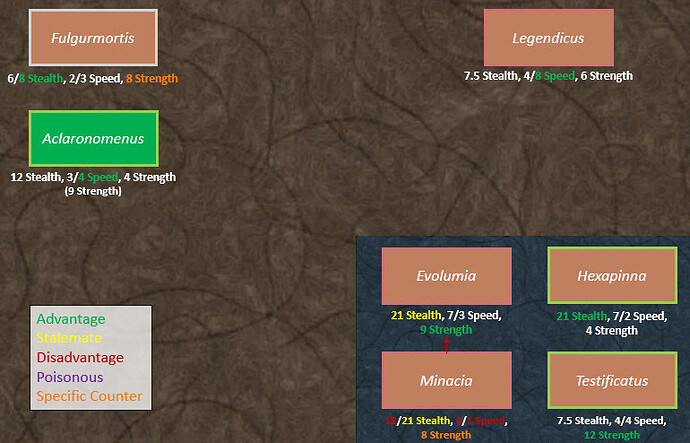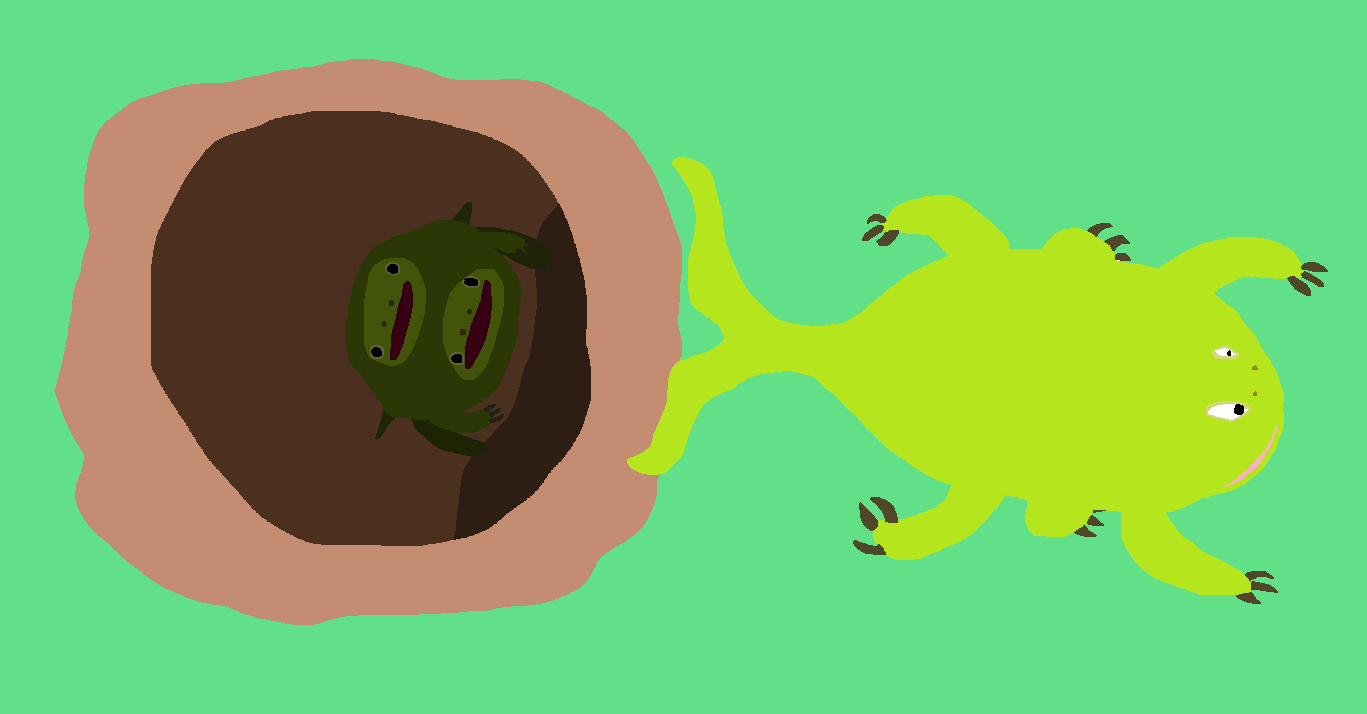Sorry again for the wait!
Some adaptations this round only affect stealth when the creature is defending (they don’t make the creature sneakier per se).
Round 14 - 140 Million Years
Species
doomlightning - Hydrobullus scutellus - LC
Mutations: Increased Size (Medium), Vocal Organ, Protective Brooding (+1 Contextual Stealth)
Hydrobullus has grown even larger than its predecessor, Fulgurmortis. Now the size of a giant tortoise, this herbivore’s osteoderms are a worthy deterrent to any other animal alive. Thanks to their size, adults living in the wetlands have no trouble feeding on Spiropteris, which they simply reach with their chelicerae.
Hydrobullus has also evolved something quite novel in its gill-lungs: muscles that beat together to make a croaking sound. These drumming muscles make Hydrobullus the first species to have a “voice.” The ability to use these in tandem with its sharp hearing to communicate is very important for another novel adaptation. When a currently-female Hydrobullus hears the high croaks of her newborn young, she gently uses her chelicerae to place them on her back. This is a purely instinctive action performed by this brainless species, but significantly improves hatchlings’ odds of survival.
Stats:
-
3*2.0 = 6 Stealth (+2 Protective Brooding)
-
2 Speed (Water), 3 Speed (Land)
-
4*2.0 = 8 Strength (Venom-Resistant)
Preys On: Chlorogyra filamentosa, Marchantinella colliosa, Porcusetum convolutus
Predated By: Legendicus transitorium
fralegend015 - Legendicus transitorium - LC
Mutations: Chemoreceptor, Balancing Tail (-1 Swimming Speed, +1 Walking Speed), Tail Whip (+1 Strength)
Legendicus has caught up with most others species in possessing olfactory nerve bundles. It uses its heightened sense of smell together with its eyes to find the plant matter making up the bulk of its diet. Its more unique recent adaptations lie in its tail. It has lengthened and stiffened in order to balance Legendicus while running. Not only that, its tip is itself long and rigid enough to act as a whip.
In other news, Legendicus is beginning to come in contact with Vigintiseptem intruding from the coasts. Of the two opportunists, Legendicus is stronger and faster, forcing Vigintiseptem to rely on its more refined senses to stay unseen. However, the Vigintiseptem are themselves fleeing from more dangerous predators like Evolumia. Is this an omen of fierce competition on land?
Stats:
-
3*2.5 = 7.5 Stealth
-
4/8 Speed
-
4*1.5 = 6 Strength
Preys On: Chlorogyra filamentosa, Marchantinella colliosa, Hydrobullus scutellus, Testificatus relictus
Predated By: N/A
aah31415 - Hexapinna verrucosus - LC
-
Tiny Herbivore
-
Habitat: Rivers
Mutations: Basic Lungs (Fossorial Air), Limb Bones (+1 Swimming Speed, +1 Walking Speed), Jaw Bones (+1 Strength)
Hexapinna now has a set of lungs to oxygenate its circulatory system. This change came about at the same time limb bones extended from beneath its fins. While both of these traits are useful for traversing the land, this herbivore instead uses them when digging tunnels above the water line. It burrows through soft mud to the other side of the river shores, then grazes freely on whatever plants it emerges among. This gives it a good degree of safety from predators, especially as their amphibious habits lead to them frequenting the shorelines.
The bones and muscles in Hexapinna’s jaws have strengthened enough to give it a respectable bite force. However, as it prefers to avoid threats entirely, it instead puts them to use gnawing on Porcusetum, which the herbivore’s new lifestyle allows it to reach.
Stats:
-
7*3 = 21 Stealth
-
7/2 Speed
-
4 Strength
Preys On: Chlorogyra filamentosa, Bryodea nodula, Porcusetum convolutus
Predated By: Minacia chirodropoides
Nonametoseehere - Aclaronomenus ascendilus - VU
-
Tiny Mixotrophic Herbivore
-
Habitat: Global Ocean, Coasts, Rivers, Lowlands, Southern Wetlands
Mutations: Reflective Spike-Fans (+1 Strength), Intricate Bioluminescence (counters Disruptive Bioluminescence), Lasers (+1 Strength)
Aclaronomenus has had to adapt quickly to the airborne threat posed by Minacia armataevigil. At first, it evolved a new spin on the producer’s thorns that unfurl into light-reflecting fans. These deflect beams cast from M. armataevigil’s mouth, allowing Aclaronomenus to shield their skin and eyes when timed correctly. However, the capacity to reflect light was soon reapplied into lasers of Aclaronomenus’s own. An almost flower-shaped array of fans surrounds a bioluminescent hotspot where a tail might be, creating a dish that can be oriented away from the hydrogen sack to fire at threats.
It’s the missile castes who make the best use of their new lasers, not least due to their larger size allowing them to fire more intense blasts. Chiefly thanks to the node castes, the species as a whole has also greatly refined their array of bioluminescent signals, preventing M. armataevigil from sending them into disarray.
Stats:
-
4*3 = 12 Stealth
-
3 Speed (Water), 4 Speed (Air)
-
4 Strength
-
Missile Caste (Small): 7.5 Stealth, 3/4 Speed, 9 Strength
Preys On: Chlorogyra filamentosa
Predated By: Legendicus transitorium, Minacia armataevigil
TeaKing - Evolumia jormengandri - LC
-
Tiny Omnivore
-
Habitat: Coasts, Rivers
Mutations: Brackish Water Adaptation, Stronger Walking Fins (+1 Walking Speed), Stronger Fin Bones (+1 Walking Speed)
Evolumia’s excretory system now adjusts urination to account for the abundance or scarcity of salts in its environment. This has allowed this species to expand into the supercontinent’s river networks. The herbivores there are not daunted by Evolumia’s presence, but this incursion is taking its toll on Minacia.
Meanwhile, Evolumia’s main pair of fins and the bones supporting them have strengthened in the past few million years. While this does allow them to paddle faster, the real benefit lies in their ability to better support Evolumia’s weight out of water.
Stats:
Preys On: Chlorogyra filamentosa, Bryopsis digitata
Predated By: Iocusis myriadus
UndyingHazard - Minacia chirodropoides - EN
-
Tiny Omnivore
-
Habitat: Rivers
Mutations: Eel Tail (+1 Swimming Speed), Aposematic Coloring (+1 Stealth), Color Vision (+1 Stealth)
Minacia’s pace in the water has increased thanks to a long tail complementing its undulating flaps. Short bursts of force even allow Minacia to leap onto shore! Meanwhile, its eyes are now refined enough to see color. This development has led to sexual selection for Minacia with striking patterns. While not very helpful for stalking prey, these bright colors do have the benefit of warning predators of Minacia’s venom.
Unfortunately for this species, its distant cousin, Evolumia, has become invasive in the rivers. Not only is it stronger and faster in water and on land, its electric organ leaves Minacia blind to its ambushes. Only Minacia’s striking skin patterns are enough to create a stalemate with its colorblind rival.
Stats:
Preys On: Chlorogyra filamentosa, Bryodea colliosa, * Hexapinna verrucosus *, Testificatus relictus
Predated By: Evolumia jormengandri
Chiori - Caedotops scolopendra - LC
-
Small Herbivore
-
Habitat: Coasts (Shore)
Mutations: Toughened Cranium (+1 Strength), Viviparity, Head Horn (+1 Strength)
Caedotops has further bolstered its defenses with a hardened skull to shield its brain. From this bony foundation extrudes a horn, which complements its pincers and makes its charges more threatening. Caedatops also now gives live birth. While mating still needs water as a medium, the young hatch at a land-ready stage of development.
Stats:
-
4*2.5 = 10 Stealth
-
5/2 Speed
-
9*1.5 = 13.5 Strength
Preys On: Chlorogyra filamentosa, Ulvopsis digitata, Kisthos thalassena, Marchantinella colliosa
Predated By: N/A
willow - Umbralysia volitans - VU
Mutations: Unicellular Blood Stream, Jet Bladder (+1 Flight Speed), Increased Chloroplast Density
Umbralysia has made a peculiar adjustment to its circulatory channels. The fluid medium within is now composed of one oversized cell. Nutrient and gas exchange now rely on vesicles - in the case of oxygen, specialized vesicles containing hemoglobin and hemocyanin are used. Like an amoeba, this cell can manipulate the filaments of its cytoskeleton to adjust its structure. Meanwhile, on the outside, another novel adaptation has occurred in the form of a pair of posterior gas bladders. One contains hydrogen like the main bladder, while the other contains oxygen. When the contents of both are allowed to combust, the explosive pressure is released through an orifice, briefly allowing Umbralysia to fly like a jet. Both of these unique features are sustained by an increase in chloroplast density on Umbralysia’s surface.
Stats:
Preys On: Chlorogyra filamentosa Kisthos thalassena
Predated By: Minacia armataevigil
zenzonegaming - Iocusis myriadus - LC
-
Tiny Omnivore
-
Habitat: Coasts
Mutations: Six Fins (+1 Swimming Speed, +1 Walking Speed), Improved Limbs (+1 Walking Speed), Air-Water Breathing
Iocusis has made several adaptations to join other animals outside of water. Its lobster-like tailfin is now accompanied by six small fins that can be used to paddle or crawl on. Meanwhile, its hooked tentacles have gotten even stronger to drag its weight out of the water. Finally, its gills have been modified to absorb oxygen from the air so long as they are kept moist.
Stats:
Preys On: Chlorogyra filamentosa, Evolumia analysia, Vigintiseptem tetrapoda
Predated By: Vigintiseptem tetrapoda
Cha - Testificatus relictus - LC
Mutations: Internalized Gills, Raptorial Forelegs (+1 Strength), Gill Pocket Muscles
Testificatus’s gills have improved in the realm of air breathing. They are now enveloped by the skin, only exposed to surrounding air by a spiracle-like opening on the bottom. Muscles surrounding the spiracle force air into and out from the gills, allowing Testificatus to actively breathe.
This herbivore’s front pair of legs have also lengthened into a pair of mantis-like claws. Like mantis claws, they are designed to grip and hold. When confronted by a predator, adult Testificatus raise their forelegs threateningly, as they can seize opponents to make delivering a venomous bite easier. They also work with the extended mouth to pull down Spiropteris leaves to eat.
Stats:
-
3*2.5 = 7.5 Stealth
-
4/3 Speed
-
8*1.5 = 12 Strength
Preys On: Chlorogyra filamentosa, Bryodea nodula, Marchantinella colliosa, Porcusetum convolutus, Spiropteris coroneta
Predated By: Legendicus transitorium, Minacia chirodropoides
sci0927 - Vigintiseptem tetrapoda - EN
Mutations: Camouflage (+1 Stealth), Internal Fertilization, Stronger Feet (+1 Walking Speed)
Vigintiseptem’s thin scales now have a mottled coloration, making it more difficult for prey and predators to see. The bones and muscles in its feet have also gotten stronger. This latter change came about at the same time Vigintiseptem’s reproductive strategy changed to center around internal fertilization. As a result, this creature is fully adapted to live on land.
However, the other salt water-drinking animals Vigintiseptem shares the coasts with have only gotten more dangerous over generations. Competition has forced Vigintiseptem to use its tolerance for water loss to set out further inland. Some even resort to frequenting the fog deserts on the supercontinent’s eastern coast, grazing on hardy Pleopodella moss. However, all of them must return to the sea to drink eventually.
Stats:
Preys On: Chlorogyra filamentosa, Ulvopsis digitata, Kisthos thalassena, Marchantinella colliosa, Pleopodella resiliens, Iocisus myriadus
Predated By: Evolumia jormengandri, Minacia armataevigil
TwilightWings21 - Minacia armataevigil - LC
Mutations: Cloud Gills, Color Changing Scales (+1 Stealth), Photoreactive Camouflage (+1 Stealth)
Minacia armataevigil can now spend more time on the wing thanks to its gills’ new ability to draw moisture from low-lying clouds. They even allow it to venture inland to attack Aclaronomenus colonies. However, it must invariably return to the ocean to replenish salts. Meanwhile, its scales have developed contractile chromatophores, allowing it to modify pigment expression. However, their real potential is only reached thanks to M. armataevigil’s multitude of eyes. As the eyes perceive incoming light from a given side of M. armataevigil’s body, the scales on the opposite side can change to match those incoming wavelengths. In other words, this flying predator is able to camouflage itself against backgrounds, not just surfaces. So long as other creatures don’t notice its eyes or any inconsistencies with surrounding light, M. armataevigil is rendered nearly invisible.
Aclaronomenus missile castes now field (sky?) lasers of their own, however, and have the advantage of size and numbers. They have also wised up to this predator’s deceptive blinking by refining their signals into something it lacks the intelligence to counterfeit. Minacia armataevigil still takes the initiative in encounters, whose outcomes depend on how quickly the missile castes can organize their response.
Stats:
Preys On: Chlorogyra filamentosa, Aclaronomenus ascendilus, Umbralysia volitans, Salixelysia radicatus, Vigintiseptem tetrapoda
Predated By: N/A
willow - Salixelysia radicatus - VU
Mutations: Gill-Roots, Bacterial Spikes (+1 Strength), Root Gametophores
Salixelysia radicatus has evolved long, flexible extensions from its gills. These retractable appendages serve as roots to draw water while S. radicata hovers above the surface. They also exchange gametes between individuals. Also on the creature’s surface are minute extrusions from the glass-cellulose exoskeleton. These spikes rake into any Minacia armataevigil that attempt to maul them. While not inflicting much damage immediately, they are hollow and filled with harmful bacteria that rapidly turn puncture wounds infected. The threat that these septic thorns pose is enough to ward M. armataevigil from hunting adults. The flying predators only risk their hides on immature Salixelysia whose bacteria reserves may be undeveloped.
Stats:
Preys On: Chlorogyra filamentosa, Kisthos thalassena
Predated By: Minacia armataevigil
…
NPC Plants
NPC - Chlorogyra filamentosa - LC
-
Tiny Producer
-
Habitat: Coasts, Rivers
Chlorogyra grows in fresh and salt water with plenty of sunlight. Its box-shaped cells line up in long filaments, their chloroplasts forming distinctive spirals. While colonies can survive anywhere in the water column, they form clusters at the surface and floor when undisturbed. In still waters, Chlorogyra can form a green carpet over rock and silt alike.
NPC - Ulvopsis digitata - LC
-
Small Producer
-
Habitat: Coasts
Ulvopsis is a marine alga that forms a thin, vertical sheet. It sprouts from well-lit sands swept by gentle currents, where entire fields of it sway. Its stern structure protects it from herbivores that lack jaws or mandibles.
NPC - Bryodea nodula - LC
-
Small Producer
-
Habitat: Rivers
Bryodea is a freshwater alga that grows in long, thin strands. It grows near the edges of rivers and lakes, where more sunlight can reach the bottom. If allowed to grow, its colonies weave together into tangled messes that are difficult to pull apart.
NPC - Kisthos thalassena - LC
-
Small Producer
-
Habitat: Global Ocean
Kisthos is a free-floating relative of Ulvopsis. Its “leaves” are much smaller and grow in chains. With the aid of minute air bladders, this alga resembling green Sargassum can maintain buoyancy at the ocean surface. This has allowed it to expand into the global ocean, where the seafloor is too deep for light to reach. Great mats of it can form wherever the currents converge.
NPC - Marchantinella colliosa - LC
Marchantinella grows in thin, fine strands. This plant is adapted to survive outside of water, and individuals coil together into a soft bed wherever they grow. Dense masses are able to cover the ground beneath them from the sun, slowing down the evaporation of water. However, they still need water to transfer gametes, so they can only grow on soils regularly saturated with water.
NPC - Porcusetum convolutus - LC
The stalk of Porcusetum houses vessels of xylem and phloem, allowing it to grow taller. About as thick as a grass stalk, individuals grow in wide curves that readily coil together. Their specialized roots are shallow and weak, so individual Porcusetum use this curving growth pattern to support one another. Hip-high thickets of this plant form in much less strict conditions than Marchantinella, even on hilltops whose soil collects little rain. Porcusetum allows its leaves to grow longer at the top when it finds support, but its stalk always has a spore-bearing head.
NPC - Pleopodella resiliens - LC
This tiny, unassuming moss evolved in the wake of a mass extinction event. Unlike Marchantinella, it favors areas where rain is scarce. Instead, its bristly coils are able to trap precious moisture from fog. Pleopodella can be found growing on the mountains’ eastern slopes, where mist is sometimes swept in from the rainy side, as well as in areas of the desert that ocean fog settles over.
NPC - Spiropteris coroneta - LC
Spiropteris is a spore-bearing plant that reaches as high as a human head. Unlike its relatives who independently support one another, Spiropteris emerges from its roots as two separate stalks, united at their tips. Both stalks coil around one another for support, growing long, bristly leaves away from their points of contact. These quill-like leaves grow longer toward the top, just as in Porcusetum. This plant’s spore-bearing head is wide and short, resembling a crown.
Habitats
Global Ocean: A vast ocean spanning the entire world.
-
Flora: Chlorogyra, Kisthos
-
Fauna: * Umbralysia*, Aclaronomenus, S. radicatus
Coasts: Warm, saline waters surrounding the supercontinent. The floor lies as deep as 150 meters beneath the surface.
-
Flora: Chlorogyra, Ulvopsis, Kisthos
-
Fauna: Aclaronomenus, Chemorecepta, Caedotops, * Umbralysia*, Iocusis, * Vigintiseptem*, M. armataevigil, S. radicatus
Rivers: A network of waterways found all over the supercontinent, but especially the West and South.
-
Flora: Chlorogyra, Bryodea
-
Fauna: Hexapinna, Aclaronomenus, Legendicus, Minacia
Lowlands: Flat plains and rolling hills spanning much of the supercontinent.
-
Flora: Marchantinella, Porcusetum
-
Fauna: Fulgurmortis, Legendicus, Aclaronomenus, Testificatus
Southern Wetlands: A rainy, humid land that the majority of rivers snake through. Its lowest areas are prone to floods, and even dry areas are pockmarked by oxbow lakes.
-
Flora: Marchantinella, Porcusetum, Spiropteris
-
Fauna: Fulgurmortis, Legendicus, Aclaronomenus, Testificatus
Great Mountains: A jagged wall of mountains at the heart of the supercontinent.
Eastern Desert: A vast rain shadow desert on the eastern half of the supercontinent.
-
Flora: Pleopodella
-
Fauna: Vigintiseptem


